
Kinemacolor Camera #108
Extremely Rare
Price upon Request
This Kinemacolor camera is, without a doubt, the most historically important camera I have ever had in my inventory. Throughout years and years of collecting it has been nearly impossible to link any early camera to any movie or event. This camera is one of only three that have had provenance. This camera shot the very first blockbuster movie in the history of filmmaking. It’s historically very interesting that this movie was also in color; it was shot in late 1911 and released in early 1912.
Outside of Edison’s museum I believe this camera to be the oldest camera that can be linked to a specific movie. Certainly this is the oldest camera available for private ownership that has provenance linking it to the very first blockbuster movie.
This camera room probably has more information in it than you wanted to know but I found this Kinemacolor camera so important that I had to write quite a bit about Albert Smith and Charles Urban and this camera No. 108. There is no way, on this web site that I can convey how important these two men were to the motion picture business. In the 1890’s and for the following twenty years Albert Smith and Charles Urban nurtured and guided the motion picture industry through its genesis, infancy and adolescence and were extremely instrumental in helping it become what it is today. Urban and Smith weren’t the only people in the beginning but they were great innovators that almost everyone in the industry looked at to see which direction could be the next moneymaker. Thomas Edison started the film business but he seemed to stall out around 1904. The innovations of Urban and Smith took the industry to a whole new and different level.
There is so much to write about this incredible early period up to the demise of the Kinemacolor Hollywood studio in 1913 that I had difficulty deciding what to leave out. Historically, this infancy is quite possibly the most important time for the motion picture industry. Two of the most important events in early film history are the first commercially viable color pictures made by Urban and Smith and the very first blockbuster film made. That film completely surprised everyone with its enormous box office receipts. Both of these events center around Charles Urban, Albert Smith and this camera. Both events changed the entire direction of the film industry and put it on the path which points directly at today’s blockbuster films, the Star Wars series, Lord of the Rings series, Jurassic Park, Pirates of the Caribbean, Titanic and the most recent, Avatar. There won’t be a last blockbuster as Cameron and Spielberg and Peter Jackson will always be replaced with new innovators, but there will always be a ‘first’ blockbuster.
George Albert Smith and Charles Urban:
Charles Urban (1862-1931) was an American that was in the motion picture business before the pioneers. He was in the Genesis group of the earliest of motion picture people. Charles Urban started in ‘animated pictures’ by opening a Kinetoscope parlor on November 11, 1894 in Detroit, Michigan. More than a year before the Lumiere brothers projected the first film onto a screen for a paying audience. Urban was possibly the first person to have a projector designed and built that was for sale to the public. His manufacturer couldn’t supply the Urban Bioscope fast enough to keep up with the demand.
Urban was asked to join the company Maquire and Baucus and in 1897 was sent to England to become its manager and the representative of Edison Kinetoscope products in Europe. One of his first managerial decisions was to move the company office to the section of London that was involved in the sales of photography and optical items and to change the company name to Warwick Trading Company. His international business allowed him to travel extensively. He crossed the Atlantic between America and Europe more than seventy times during his career and he met with the Lumiere brothers at their studio in Lyon France in an attempt to buy a camera. They wouldn’t sell Urban a camera but he was instrumental in convincing them to change their film from a single perforation per frame to the American standard of four perforations per frame. In the early days there were no standards. Innovators and companies just made what worked for themselves.
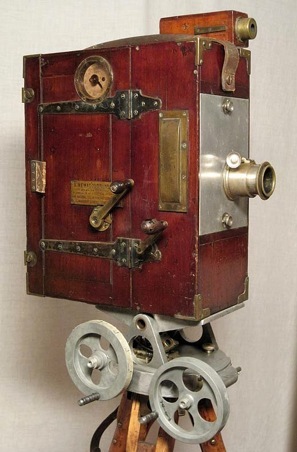
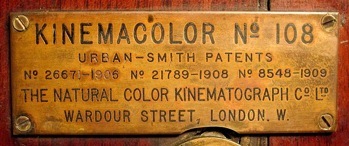
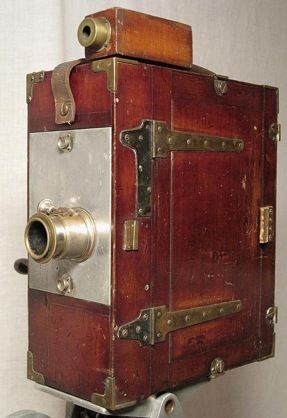
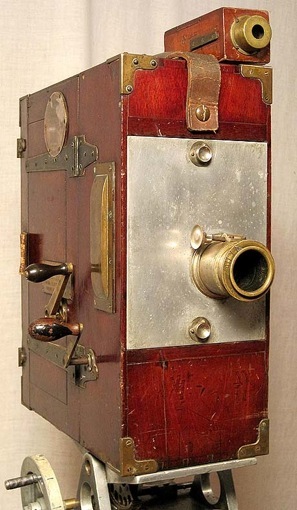
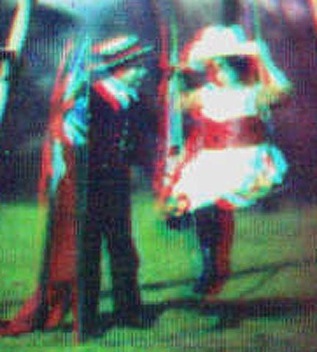
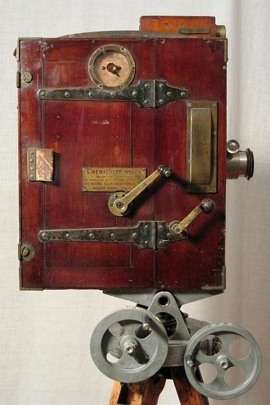
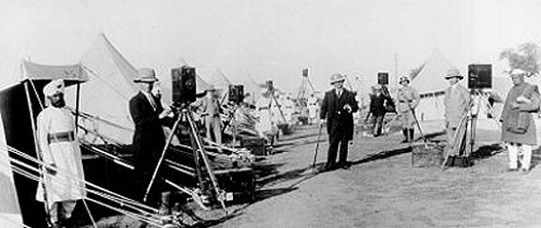
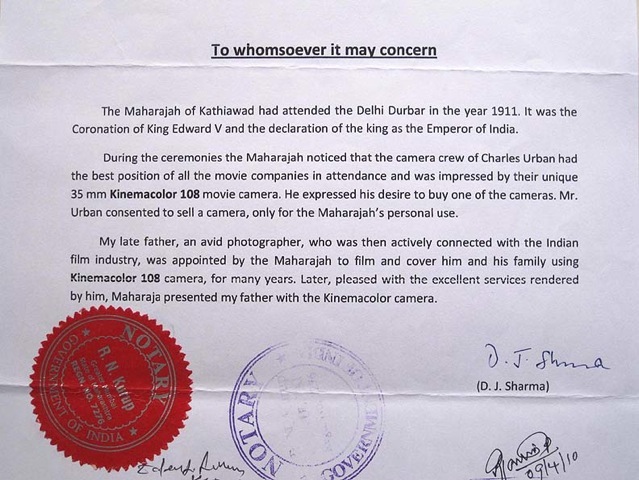
Urban couldn’t buy a camera anywhere as Edison and Lumiere only leased them. Edison couldn’t supply enough films to keep up with the demand so Charles Urban went to mechanical engineer Alfred Darling and asked him to design a camera. Urban wanted to make his own films to fill in the supply gaps. By this time Urban had already had a projector made so a camera couldn’t be that much more difficult. Darling made the Urban Bioscope and Urban first started producing films in 1898. (Steven Spielberg is the caretaker of one of the finest examples of an Urban Bioscope anywhere. He probably should have this Kinemacolor camera to go along with it.) Urban was in the motion picture business before it was called the motion picture business and early terminology often called movies Bioscopes and theaters Bioscope Parlors after Charles Urban’s cameras and projectors.
Charles Urban was a brilliant man that took to the new animated pictures as if the he and the business were designed for each other. He understood the business of animated pictures and was able to make a long and profitable career where many had failed.
He formed the “Charles Urban Trading Company” in 1903. Urban’s film sales company was called “Urbanora”. This was so early in the film industry that the hundreds of film titles listed in his catalog gave length of each movie in feet. The average length of each is less than 300 feet, or less than five minutes screen time. Most companies sold movies by the foot. Three cents a foot was an average price. Urban’s company sold movies by the title. In those days once you had purchased a print it was yours forever. It seems ridiculous to us now but this was normal for the period. Short films were the norm as no one had dared to make a scripted feature length film before 1911. No one thought that the audience had an attention span that would let them watch a movie over ten to fifteen minutes long.
Until 1911 most films were Vaudevillian slapstick style comedies or ‘actualities’. Actualities were films made at the seaside, trains coming and going, ship launchings or historical events. Almost all films were actualities as people really hungered to see events in foreign places. Some Shakespearian plays were filmed but because of the extremely short length of films during this period the original content was lost or confusing at best.
George Albert Smith started his career in the film industry with the earliest of the film experimenters. He made his first films in 1896/7. As far as I can tell Smith has the record for having the first re-shoot of a picture. He shot “The Miller and the Sweep” first in June of 1897 and then re-shot it in September 1897. For some reason his first film didn’t work. Run time was six minutes. Believe it or not a six-minute run time was very long for a movie in 1897. Like Urban he was in the movie business before they were called movies. He refers to himself in the legal text of his two color patent application dated November 22, 1906 as an “animated picture maker”. The term ‘animated’ separated moviemakers from still picture makers.
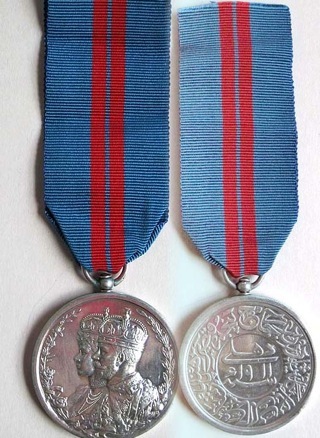
Above is a fine example of what fringing looked like. All the items and things that are not in motion do fine in Kinemacolor, even things that move slowly are OK. Things in fairly quick motion have fringing as seen in the girl on the swing. The red and green frames are superimposed over each other to make the fringing evident.
United States Patent Office patent number 941,960. George Albert Smith’s Kinematograph Apparatus for the Production of Colored pictures. Applied for June 11, 1907. Granted November 30, 1909.
Kinemacolor’s patent was revoked April 26, 1915.
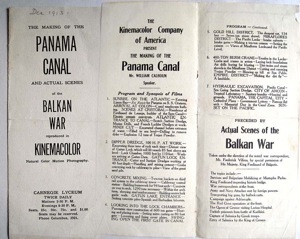
Smith also shot some of the earliest special effects, thus a special link to “Avatar” and James Cameron. His ‘The Visit of Santa Claus’ 1898, can be seen on YouTube. Early special effects from more than a hundred and ten years ago are of great interest to watch. Smith’s wife was often one of the main characters in his movies. She plays the Nanny in this movie. It’s a minute and seventeen seconds long.
Another early film genius was Edward R. Turner who received a patent for his invention of a three-color filming process in 1899. In 1898 Turner asked Urban for assistance in obtaining his patent in exchange for part of the royalties. After the sudden death of Edward R. Turner, Urban bought the patent rights and George Albert Smith took over Turner’s experiments in color cinematography at the Urban Trading Company lab in 1903/04.
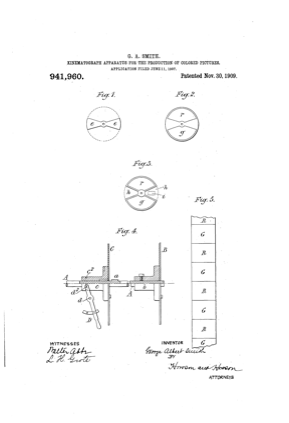
A silver medal from the Delhi Durbar comes with the camera. It is unnamed so it’s not known to whom the medal was given. There were only 26,800 silver medals struck for the coronation. It is a little heavier than an American Silver Dollar of the period.
All films at all theaters were changed out frequently, mostly once a week but sometimes as often as three or four times a week. Charles Urban‘s Delhi Durbar film ran for months in a single theater, the Scala. The show lasted some two-and-a-half hours. A huge set piece of the Taj Mahal was built on the Scala stage and duplicated again at Carnegie Hall in New York. Music was specially composed and a forty-eight piece orchestra, a chorus of twenty-four, a twenty-piece fife and drum corps, and three bagpipes were all in the orchestra pit. No one had ever done anything this elaborate or expensive for a movie before. It was an enormous hit. Any one who saw Urban’s film saw the Royal trip to India and the Royal Coronation and Durbar better than anyone that had attended it.
Other prints were taken on tour around England to show to those people that couldn’t travel to London. It was the first huge blockbuster movie and made about 150,000 British Pounds or $750,000 in its first year of exhibition. A box office record of $750,000 was never even dreamt of in 1912. Urban became the film industry’s first producer/director/cameraman superstar. He’s the patriarch of the family of superstar men that leads directly to James Cameron.
King George V liked Charles Urban very much and after the great success of the film of the Delhi Durbar he wanted to bestow Urban with great honors. The problem was that Urban was an American and all the honors the King wanted to give him were reserved for British subjects. He asked Urban what he would like and Urban replied he would like to be “The King’s Kinemacolorist.” Urban had a framed document containing a picture of the King and Queen and signed by the King hanging on the wall in his drawing room at home declaring him The King’s Kinemacolorist.
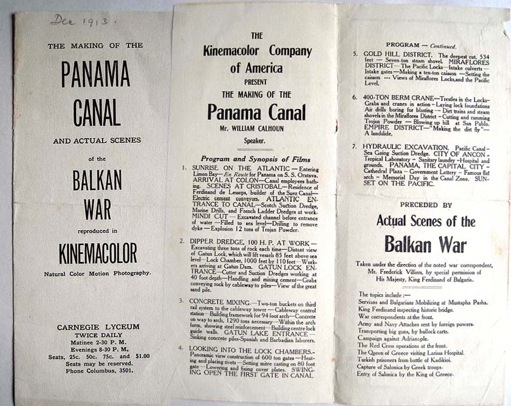
The camera comes with this playbill dated December 1913. The Kinemacolor show was important enough to be booked into the Carnegie Lyceum, which is now Carnegie Hall, Midtown Manhattan. Any show that gets into Carnegie Hall is an important show. The Making of the Panama Canal and other Kinemacolor films cost quite a bit more than regular movies and you could reserve seats. The prices were 25c, 50c, 75c, and $1.00. For comparison, a regular movie was 5c in 1913.
Kinemacolor released the first natural color dramatic feature length film in July of 1914. It was shot in Hollywood but the box office was disappointing. It seems it was too late to save Kinemacolor. They were being sued in court over other people’s prior use of color and the term ‘natural color’ in the patent wording. Charles Urban won the challenge but lost on appeal and their patent was revoked April 26, 1915. Interestingly, Technicolor was founded in 1915. Having Kinemacolor’s patent revoked opened the door for all color companies to come into the market.
It’s not exactly clear when Kinemacolor purchased or built its studio in Hollywood, 1909 seems to be the most popular year with Hollywood historians. What is clear is that in late 1913 or early 1914 D. W. Griffith took over the Kinemacolor Studio at 4500 Sunset Blvd. He took over Kinemacolor's failed plans to produce Thomas Dixon's “The Clansman”, which eventually became Griffith’s “The Birth of a Nation” (1915), the second huge blockbuster movie. It was because of the financial failure of Kinemacolor that Griffith got the rights to “The Clansman/Birth of a Nation” and made his own huge blockbuster. Kinemacolor started to produce “The Clansman” in New Orleans but something went terribly wrong and they stopped production. It seems that D. W. Griffith’s wife was in a starring role in the Kinemacolor failed version. Griffith had intimate knowledge of the screenplay before acquiring the rights for himself.
I have no doubt that Kinemacolor could not have made a good movie out of The Clansman as they had almost no success with ‘story pictures’. It’s a good thing that Griffith got the rights when he did. He made a very controversial masterpiece that took the box office by storm.
From 1920 to 1922 Charles Urban built a huge complex at Irvington-on–Hudson, New York, just twenty miles north of central Manhattan, and moved his library of two million feet of film to his new studio. His new parent company was named Urban Motion Picture Industries and the business was called The Urban Institute. Urban seemed to be stuck in what we now call documentaries and travel pictures. He had little interest in fiction or story pictures and by 1924 his company went under.
With his career in the motion picture business over, Urban moved back to England in 1929 and died there in 1942.
Now on to the camera.
The camera comes with a wonderful tripod and gear head. The look of these together is unbelievable. The cameraman that put these crank wheels on this head was an early innovator himself. The weight of the wheels would make the panning and tilting image on the screen smooth and easy to watch. I am sure his footage was the best for his day.
A shared first patent in 1906 by two of the very first filmmakers in history makes this camera monumentally important. George Albert Smith made his first film in 1897, a full nine years before their Kinemacolor being first patented in 1906. Charles Urban shot his first film in late 1897 or early 1898. By 1906 Charles Urban was a seasoned, innovative veteran in the film industry and a leading edge director/cameraman and producer.
The camera cranks smoothly and easily. It passes film without a scratch. Actually, if one were to remove the color filters this camera would shoot today’s regular film stock.
The engineering on this camera is astounding. The Moy and Bastie movement is almost always chain drive. This Moy camera had to have a full set of extra gears inserted in the mechanism in order to drive the second shutter, the color shutter, at half speed to the regular shutter. The necessary timing for two shutters didn’t allow this camera to have a Moy chain drive for one of the shutters and have gears drive the other.
Charles urban used only the highest quality lens. It is a 1902 design Heliar f/4.5 serial number 108166 that was manufactured in early 1910. The Heliar patent states that the lens possesses great color distribution. Better color distribution would mean a broader grey scale and that made Kinemacolor work even better. This color distribution claim is astounding during the period of only black and white film. I’m certain that Urban chose this lens because of its color distribution claims.
Almost every camera maker started serial numbers with 101. That would make this the eighth camera made by Kinemacolor. I would assume that the first two or three were prototypes and used as in-house experimental cameras seeing as most manufacturers kept at least two experimental cameras in the shop to work with at all times. They always had to think of new ways to make their cameras more useful to the customers and had to keep making them better than their competitors’ cameras.
I have seen a very few (4) of the limited number of Kinemacolor cameras but none have had the Patent Tag on the side and none have a Kinemacolor serial number except this one.
The movement is based on the Charles Urban Bioscope camera’s pulldown claw system inserted into a Moy and Bastie camera body with other modifications to allow for the camera to shoot at thirty-two frames per second and have two shutters running at different speeds. Charles Urban asked Alfred Darling, an early camera maker, to make the modifications. I find it very interesting that the Genesis period people were not quite as full of secrecy and rivalry as later years. Yes, they did protect themselves with patents but they often shared some knowledge with competitors. That behavior became quite scarce very soon.
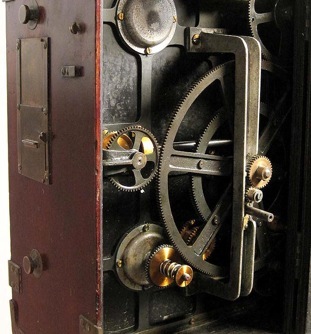
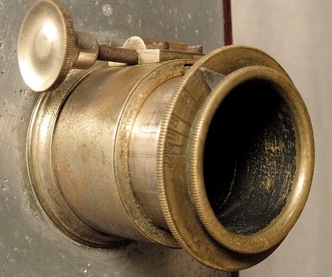
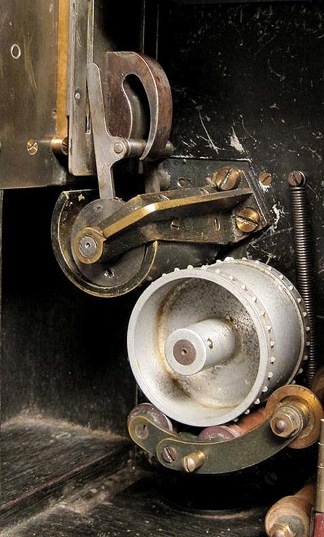
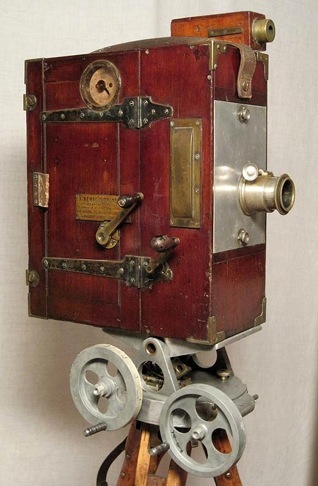
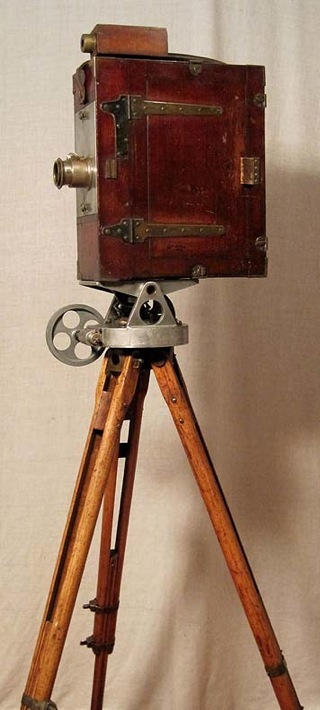
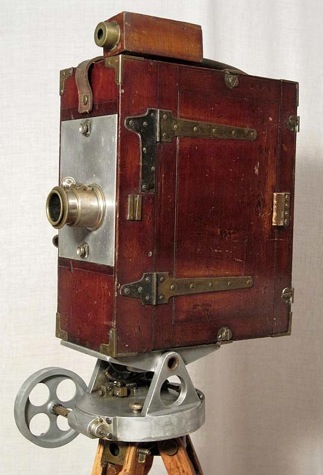
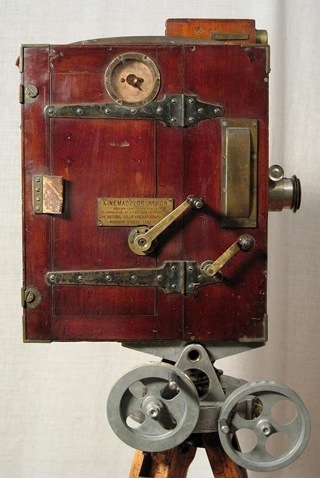
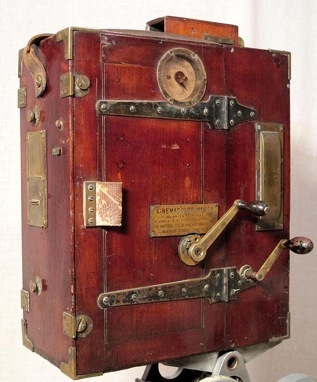
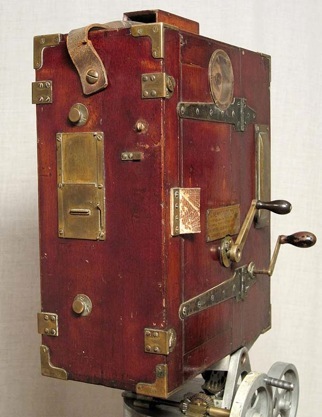
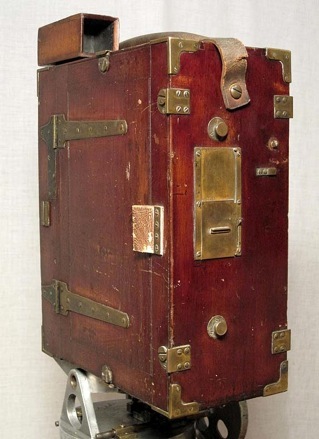
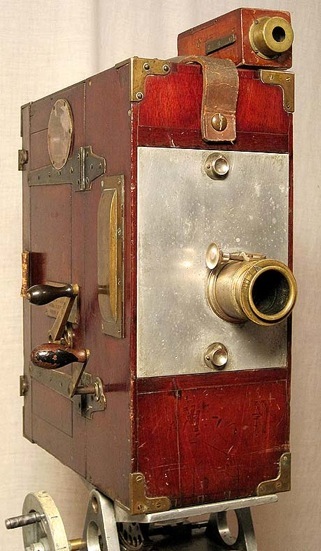
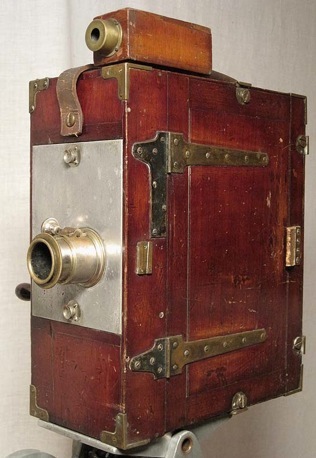
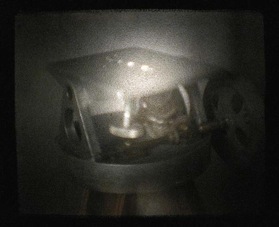
This is a short video of the two shutters in action.
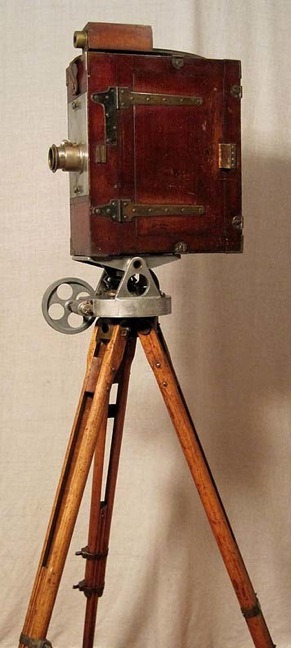
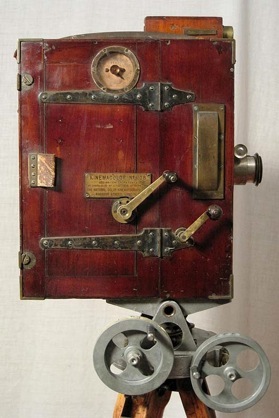

The three-color process was deemed unworkable so Smith experimented with a two-color process and received the first two-color patent, number 26671, in 1906. (A larger image of the nameplate is available in the photos page.) The two-color process will be explained in detail after the text describing the Kinemacolor camera itself.
A two minute twenty-four second scientific practical demonstration test was shot in late 1906 called “The Tartans of Scotland”. One of the irresolvable problems with Kinemacolor was a kind of parallax that came about because the red and green frames were exposed a 16th of a second apart. This meant that anything moving close to the camera would have color fringing where the red or green frame was a little behind the other so there was an obvious red or green fringe to the object in the picture. If you watch “The Tartans of Scotland” on YouTube you will see the woman moves quite unnaturally slow and the Tartans are taken out of frame quite slowly. Shooting this way the ‘fringing’ wasn’t apparent in the demo. “A Visit to the Seaside” from 1908 was the first commercially successful Kinemacolor movie. It’s an eight-minute short film of people on Brighton Beach. George Albert Smith directed it. It is ranked of high historical importance.
The royal family in England had seen Charles Urban’s color films and had asked for command performances of color films at Buckingham Palace. When the newly crowned King George V was to be the first monarch to travel to India to attend his Durbar declaring him Emperor of India, Urban and Kinemacolor were given special status as guests of India and of the King-Emperor. Because of Urban’s status with the King he was given special camera positions over the other production companies. He was closest to the royal couple and had a movable platform that put his camera above the head height of the thousands of people in the parade. He also brought a giant tripod that put one of his cameras up around twelve feet above the ground. He was the only one filming in color. That is Charles Urban with the cane and the cigar. He smoked about twenty cigars a day.
A notarized letter from Dilip Sharma stating that Kinemacolor camera #108 was purchased from Charles Urban by the Maharajah of Kathiawad.
The Maharajah of Kathiawad noticed the privileged positions of the Urban team. At that time in India all things and people were considered by rank and station and Urban had better viewing positions than almost everybody. The Maharajah discovered Urban was shooting color from those positions and asked to buy one of the cameras. Indian Maharajahs were known for their incredible wealth and their rather naïve, child like interests. They also had a ‘money is no object’ approach to things they wanted. The Maharajah bought one of Urban’s cameras at the end of the Royal visit to India with the stipulation from Urban that it be for personal use only.
The Dubar at Delhi was the grandest procession up to this time. There were over sixty thousand spectators in the stands and fifty thousand participants and untold thousands more behind the bleachers. At the Delhi Durbar the King made a proclamation that the capital of India was being moved from Calcutta to Delhi. He even laid the cornerstone for the construction of the new capital to be named New Delhi.
The picture above was taken through the viewfinder on the top of the camera. The picture is of the gear head on top of the tripod. I’m not sure how it’ll read online but I thought it would be fun to post it anyway.
For those of you that understand motion picture camera shutters I offer the following technical information. This camera has two shutters. One normal blanking shutter and the second shutter has two color filters in it. This camera shoots at thirty-two frames per second; this is double the normal sixteen fps of the period. The second shutter runs at half the speed and has two openings, one for a red filter and the other for a green filter. Each alternate frame was exposed to either red or green filtered light. After the film was processed and printed it was projected through another red and green color filtered shutter at 32 fps giving the first natural color image seen on any motion picture screen. Human persistence of vision gave the illusion of color but the alternating red and green flashes bothered a few people in the audience and gave some others a headache. Kinemacolor was only in business from 1908 to 1914. Urban didn’t actually give the process the name ‘Kinemacolor until 1908. In 1909 he first publicly screened a Kinemacolor movie. It was called “A Visit to the Seaside at Brighton Beach”. It still exists and can be seen on YouTube. Look for ‘Kinemacolor Demo’.
When I talk about this camera to collectors and friends I find that I start to start to stutter. There just aren’t many really important cameras available to the public. Almost all important early cameras are locked up in museums. Having an important camera that belonged to one of these early, early pioneers puts me at a loss for words.
Just a side note: It would be interesting to have the two million feet of negative in Urban’s library as all of it was shot before the end of World War I. Unfortunately, except for a couple of thousand feet, it all seems to be lost.
For those of you that want some more technical information: Here are several reasons color wasn’t popular and with the exception of the Delhi Durbar, color films didn’t seem to make money. Kinemacolor and in fact all color processes were very expensive. The three-color process used three times as much film to get the same screen time as a black and white film did. The film of the period was Orthochromatic and didn’t register red wavelengths of light well. Some bad news comes with this. To get the color red to register you had to buy film that was chemically treated. Regular film cost about three cents a foot but black and white film chemically treated for the color processes cost seven cents a foot. It had to be loaded in a black darkroom and developed in a black darkroom. Normally one could load and develop film using a red color safe light. The cameras ran at thirty-two frames per second for the two color process and forty-eight frames per second for three color process. So the film cost more than four or six times as much as regular black and white. Color films required a special projector to screen them. The high speed projection beat the prints up so much that they had to be changed out more frequently than B&W films. Buying the neg cost more than double, shooting used twice or three times as much film developing costs were double or triple and printing to positive used twice or three times as much film. Special cameras and special projectors and special operators for both added a lot more to the production costs. Box office prices couldn’t be three or four times as much. The viewing audience wouldn’t pay that much more just for color. No pun intended but color movies faded out of production until a better solution could be found.
After further research it seems that the three color process flashed frames too quickly for human persistence of vision to take place. Forty-eight flashes per second happened too quickly. Two colors at thirty two flashes per second worked best. There never was color on the film. It was always black and white and every other frame was projected through a red or green filter. The camera exposes film through a red filter and those images had an almost clear spot where there was red color in the original scene. When projected through a red filter the clear spots where red was missing became red and the same for the green alternate frames. Human persistence of vision blended the red and green in the viewer’s visual cortex and the resemblance of color was filled in by the human brain.
Credit where credit is due:
Many, many thanks to Dr. Luke McKernan for his extensive research on Kinemacolor and Charles Urban. He has done the history of the motion picture industry a great service.
Stephen Herbert is such a wealth of energy and information that much of what you read here wouldn’t be possible without him. He is another person that continues to do a great service to the preservation of early film history.
Stephen Bottomore wrote extensively on the early film experimenters. His depth of research has been invaluable to much of the information I have written here.
Dr. Nicholas Hiley: Dr. Nick has been a friend for many years and always seems to be a great source of vital help just when I feel stuck for an answer. Thanks Nick.
Michael Harvey is in charge of the majority of Kinemacolor equipment left. It is in the National Media Museum. Thank you Michael.
All of these men contributed greatly to the information and photographs I have used in this Kinemacolor camera room.